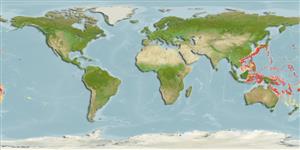Environment: milieu / climate zone / depth range / distribution range
بوم شناسي
دريايي نزديك كف زي; تغييرات عمق 148 - 956 m (Ref. 116586). Tropical
Disjunct distribution: Northwestern Pacific off southern Japan, Taiwan and the northern Philippines and Southwestern Pacific from the Coral Sea to Vanuatu; none from the tropical low latitudes.
Size / Weight / سن
Maturity: Lm ? range ? - ? cm
Max length : 11.0 cm SL جنس نر / بدون خواص جنسي; (Ref. 116586)
توصيف مختصر
كليدهاي شناسايي | ريخت شناسي | ريخت ستجي بوسيله انداره گيري
خارهاي باله مخرجي: 3; شعاع نرم باله مخرجي: 6. This deep-bodied species is distinguished by the following characters: convex dorsal head profile; A III + 6 in >6.5 cm SL specimens; pectoral-fin rays 16-18 with length 21.5-27% SL; gill rakers 15-18; pseudobranchial filaments 16-23, increasing with size; first anal-fin pterygiophore is long, slightly forward bent, with very broad tip and hollow; ectopterygoid with a single row of denticles; orbit diameter 11.7-13.3% SL; otolith compressed (OL:OH = 1.45-1.55) (Ref. 116586).
Found on the continental slope (Ref. 75154).
Life cycle and mating behavior
بلوغ | تولید مثل | تخم ریزی | تخم ها | Fecundity | توزاد ( لارو)
Schwarzhans, W.W. and A.M. Prokofiev, 2017. Reappraisal of Synagrops, Günther, 1887 with rehabilitation and revision of Parascombrops Alcock, 1889 including description of seven new species and two new genera (Perciformes: Acropomatidae). Zootaxa 4260(1):1-74. (Ref. 116586)
وضعيت در فهرست قرمز IUCN (Ref. 130435: Version 2024-2)
خطر برای انسان ها
Harmless
استفاده انسانی
ابزارها
گزارش های ويژه
بارگيری XML
منابع اينترنتي
Estimates based on models
Preferred temperature (Ref.
123201): 15.3 - 26.8, mean 22.3 °C (based on 220 cells).
Phylogenetic diversity index (Ref.
82804): PD
50 = 0.5001 [Uniqueness, from 0.5 = low to 2.0 = high].
Bayesian length-weight: a=0.00977 (0.00436 - 0.02192), b=3.01 (2.81 - 3.21), in cm total length, based on LWR estimates for this (Sub)family-body shape (Ref.
93245).
Trophic level (Ref.
69278): 3.5 ±0.5 se; based on size and trophs of closest relatives
Fishing Vulnerability (Ref.
59153): Low vulnerability (10 of 100).
